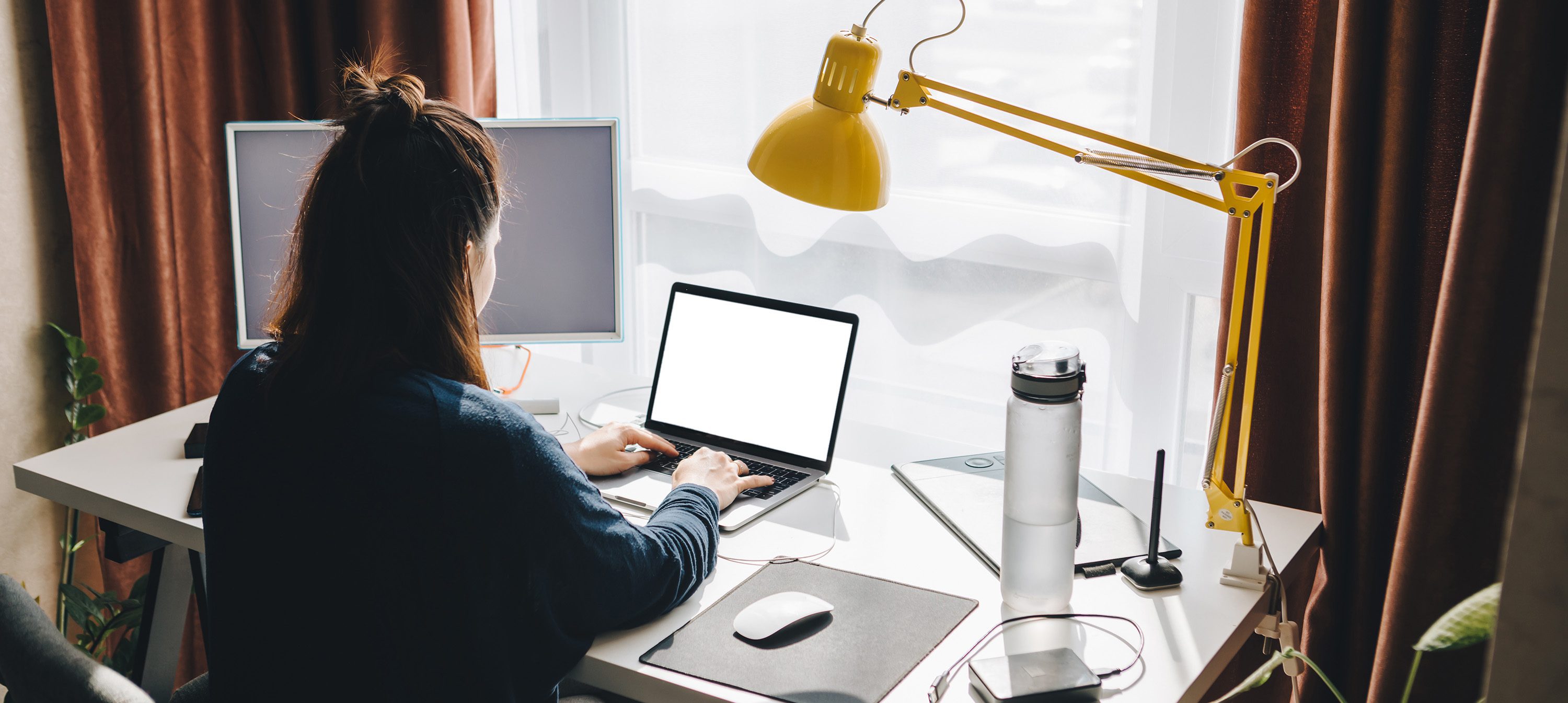All you need to know about the effects of remote work on dry eye syndrome
Home office has become the new normal for thousands of workers around the world. For some, this represents the possibility of being able to organize their schedule as they please, and to work in the environment of their choice. However, there are several downsides of working remotely on our health, including our eye health. We spend our days in front of a screen without moving, obviously this has consequences. Dry or red, itchy eyes, a feeling of glued eyelids… Dry eye syndrome can be really disabling … In this article, we tell you more about the effects of remote work on dry eye, and how to fight against this pathology.
Understanding dry eye syndrome and its causes
When they’re healthy, your eyes constantly produce a tear film that acts as a protective barrier against the outside elements, and keeps the eyes moist at all times. With some people, these tears are not produced in sufficient quantities, or evaporate too quickly. They can then lead to tingling sensations, irritation, itchy red eyes, blurred vision or even sensitivity to light.
Two types of eye dryness
We observe two types of eye dryness in patients :
- Aqueous Deficient Dry Eye (ADDE) : can be caused by low tear production, a lacrimal gland abnormality, meibomian gland dysfunction, a hormonal disorder, medication (contraceptive, antidepressant) or recent laser surgery.
- Evaporative Dry Eye (EDE) : this occurs in 86% of cases. Here, the tears are produced in sufficient quantities, but evaporate too quickly. The causes can be either inflammation of the eyelids (blepharitis) or unsuitable contact lenses.
Too few consultations for eye dryness
Although it’s very inconvenient for people suffering from this condition, dry eye is very poorly diagnosed, although it affects up to 30% of people over the age of 50. But why so few consultations? Most of the time, patients think this is an age-related condition, and that nothing can prevent or relieve these ailments. Of course, it’s true that the older we get, the more our eye health is compromised. However, there are many external factors that can also play a role in dry eyes, such as screens!
Why does dry eye syndrome occur more with home office?
Doing home office has completely changed our daily lives, and its positive aspects are often highlighted: more productivity, a more pleasant and friendly working environment, less stress related to travel time, personalized planning of schedules and activities. … In short, remote work is popular with a good number of workers, and it’s not about to stop.
However, it seems important to emphasize that with the extension of this new way of working at home (let’s not forget the students who still take their class from their home, and who also spend their entire days in front of their screens), some conditions have developed. This is particularly the case with dry eyes, linked to daily overexposure to screens, and a much longer time spent in front of our devices. By staying focused for long consecutive hours, working or studying, our eye blinks are much rarer. Blinking your eyes secretes the tear film, which lubricates and hydrates your cornea. Without this lubricant, your eyes will dry out and you will experience stinging, red eyes, irritation, burning sensations or even blurred vision.
In addition, this isn’t to mention the blue light emanating from our screens which, viewed over the long term, can cause eye damage.
How to prevent remote work-related eye dryness?
On a daily basis, it’s easy to fight eye dryness symptoms. Think of these tips below as a routine to incorporate into your day to ensure that you are getting good eye hydration.
Limit screens and take regular breaks
The first thing to do is to take regular breaks during your day, as well as to limit your exposure to screens. Of course, this can be difficult from person to person, due to personal and professional obligations, but it’s truly necessary! For instance, after your workday, grab a book or go out and get some fresh air instead of sitting on the computer or sitting in front of the TV to relax.
Adopt the 20-20-20 rule
Optometrists advise the following practice during your workday: take a break off your screen every 20 minutes, and observe for 20 seconds an object about 20 feet (6 meters) from you. At this point, blink 10 times, slowly. This will stimulate your tear film production, reduce your eye strain and give your cornea a hydration boost.
Get some fresh air outside, in natural light
Know how to take some breaks outside during the day, in natural daylight. You will come back to your desk much fresher, with rested eyes and a brain ready to work at full pace!
Limit air conditioning and humidify rooms
With too much air conditioning, the ambient air becomes much too cool and dry. This can significantly increase the symptoms of dry eye, in addition to putting you at risk of catching a cold! Don’t hesitate to ventilate your rooms well, so as to bring in moisture, which is valuable for lubricating your cornea. You can also use a humidifier!
Adjust your workstation for better ergonomics
Contrary to popular belief, posture is very important when it comes to reducing eye fatigue and dry eyes. Make sure to position the top of your screen at eye level, so as not to look too down or too much up, but straight in front of you. Your eyes won’t strain unnecessarily, and your neck and back will thank you!
Monitor your lifestyle
Overall, a healthy lifestyle is a determining factor in the development of dry eye symptoms. For instance, it’s recommended that you remove your contact lenses (if you have any) as soon as you finish your workday, rather than before going to bed. Regular physical activity frees you from the screens, stopping smoking is advised because smoke is very harmful to your eye and overall health. Finally, hydration throughout the day, as well as a varied and colorful diet is essential!
What treatments for dry eye syndrome related to working remotely?
Know that even if the recommendations set out above are important to implement in your daily life, if your symptoms of dry eye persist, we advise you to consult an optometrist. They will perform an eye exam with you and direct you to the appropriate treatments to relieve your symptoms.
Lubricating solutions
Lubricating solutions, such as I-DROP® Viscous Adaptive Eye Drops (Artificial Tears) are a great way to fight dry eyes. In addition to providing long-lasting relief and comfort, these solutions stand out because they contain no preservatives, and require few daily applications, for superior results and long-lasting lubrication.
More advanced clinical treatments
If the solutions and drops are not sufficient, there are more advanced treatments offered by some clinics, including your VU optometrist. Among them are:
- Pulsed Light (IPL): this technique has been on the dry eye treatment market for 10 years. Very innovative, pulsed light is offered by very few professionals to date, and your optometrist VU is positioned as one of the few clinics providing this technology. Unique in its kind, the treatment of dry eye by gel-free and self-calibrated IPL stimulates the meibomian glands, and thus prevents too hasty evaporation of the tear film. The technology has improved the comfort of over 80% of patients to date. Completely painless and very quick, the treatment is carried out in just 3 to 4 sessions, spaced between 2 weeks and 1 month.
- LLLT (Low Level Laser Therapy) mask: this mask is used to treat dysfunction of the meibomian glands, responsible for the production of tear film. This type of treatment uses infrared light at a wavelength close to natural light, and produces a reaction in cells called a biochemical photoreaction. LLLT increases the speed and quality of healing of damaged tissue. The treatment lasts 25 minutes, is completely painless and doesn’t require you to be accompanied.
As remote work seems to be the new habit, even if people timidly come back to the office, the simple tips above can significantly reduce your eye discomfort. To make sure you’re given good, fast and effective care, don’t hesitate to consult your optometrist when experiencing the first symptoms, in order to perform an eye exam.


![Les tendances lunettes de soleil [été 2021]](https://b3691665.smushcdn.com/3691665/wp-content/uploads/2021/05/Les-tendances-lunettes-de-soleil-ete-2021_blog.jpg?lossy=1&strip=1&webp=1)
